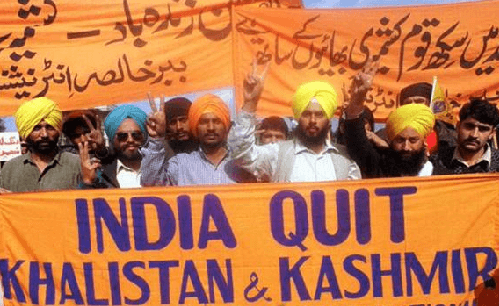With more and more opposition political parties in India joining the ongoing farmers’ agitation against the Modi-government’s “agricultural reforms laws”, the well-funded Khalistani separatists, based outside the country, seem to be losing the plot of reviving their violent mission of carving out an independent Sikh nation.
China Commissions More J-16 Fighter Jets To Counter Growing Indian Fleet Of Rafales, Su-30 MKIs
It has been widely reported how under the active guidance of Pakistan’s intelligence agency ISI, one Gurpatwant Singh Pannu, the so-called legal advisor to ‘Sikhs For Justice’ (SFJ) outfit, has been mobilizing resources and public opinion in Europe, the United States and Canada to ‘liberate Punjab from India’.
The outfit is seriously trying to infiltrate agitation in India and its supporters outside and linking this effort with its proposed referendum involving Sikhs all over the world, which originally scheduled to be held in November but now “postponed” to next year.
In order to keep up the momentum for the so-called referendum, Pannu and his colleagues have made serious attempts to entice the Sikh farmers from Punjab who are playing a leading role in the agitation. They are also doing the same in supporting rallies for these farmers organized now by the prosperous Punjabi diaspora across the continents – from the UK to Canada, America, and the Antipodes (Australia and New Zealand).
In the rallies in London, the Times of India has reported how some protestors carried yellow ‘Khalistan flags’, but the majority of them have tried to clarify that “the issue is not about Khalistan or Sikhs”. But the SJF is reportedly planning a separate ‘Kisan (farmers’) rally’ in London on December 10 in solidarity with the ongoing protest by farmers in India. The Indian High Commission in the United Kingdom has raised this matter with UK’s Metropolitan police. Khalistani posters have also been displayed in a recent rally in New York as well.
How The Plot Was Exposed
In India, a section of media ( DNA, for instance) has carried out reports on how some tractors of the agitating farmers on the Delhi-border carried posters imprinted with ‘Khalistan Zindabad’ slogan and a picture of an AK-47 rifle. The DNA report also showed Khalistan supporters stating that what happened with former Prime Minister Indira Gandhi would also happen with Prime Minister Narendra Modi.

Congress leader and party MP from Ludhiana, Ravneet Singh Bittu, has told The Tribune newspaper that the ongoing farmers’ agitation is being hijacked by vested interests. He said people “whose protests have failed in the past – be it those who sat in agitation at Shaheen Bagh or a section of students who protested against the Citizenship Amendment Act and also some Khalistani elements have penetrated the ongoing protests”.
Even before the outbreak of the farmers’ protests, the Khalistani extremists have tried hard to resurrect the insurgency in Punjab that had ended in the 1990s. A report in the India Today magazine has given the details on the busting of six terror modules and the arrest of 23 Khalistan terrorists in Punjab since April 2017.
The interrogations revealed the links between the cadres arrested in Punjab and the Sikh extremist leaders like Lakhbir Singh Rode (International Sikh Youth Federation chief) and his cohorts based in Western Europe and Khalistan Liberation Force’ Harmeet Singh (alias Happy PhD), allegedly sheltered in ISI safe-house near Lahore military cantonment in Pakistan.
Similarly, there have been systematic attempts to use social media by these groups to spread the (mis)perception that how under the “Hindu nationalist” Modi regime, Sikhs are being meted out injustice. The Indian agencies have detected 140 Facebook messenger groups, 125 Facebook pages, and hundreds of WhatsApp groups being used to radicalize Sikh youth in Punjab.
The Money Trail
The SJF is now trying to woo the Punjab farmers by offering Rs 3,500 each as a grant every month, particularly to those who have defaulted on agricultural loans. According to India’s National Investigation Agency (NIA), which is probing cases against SJF, this offer earlier was Rs 3,000 each.
If the NIA officials are to be believed, capitalizing on the ongoing protests by farmers, SJF has planned to distribute $1 million among farmers who had defaulted on agricultural loans.
ANI quotes DSGMC Pres Manjinder Singh Sirsa: We've sent legal notice to Kangana Ranaut for her derogatory tweet calling aged mother of a farmer as woman available for Rs 100. Her tweets portray farmers protest as antinational. We demand unconditional apology from her pic.twitter.com/NWLXbRLsVk
— The Times Of India (@timesofindia) December 4, 2020
The Khalistani radicals have been reportedly worked on mixing this “help” to the farmers with mobilizing support for the so-called referendum. They are offering each of those who can register 25 votes for the referendum Rs 7500 each as a monthly stipend on their Canadian and Russian portals.
However, despite their attempts to fish in the troubled water of farmers’ agitation, the Khalistani radicals operating outside India are unlikely to make any gain.
Why The Plan Will Fail
Supporters of the Sikh and farmers in Europe and the Americas may have their political backers, given the community’s relative prosperity and number. But, this political support, be it from Members of Parliament in Britain or Canadian Prime Minister Justin Trudeau, is not to be equated with support for the demand of a Khalistan.
All told, it is Trudeau’s minority government, despite its vital dependence on the Sikh leader Jagmeet Singh’s New Democratic Party for the survival, that has banned the proposed referendum for Khalistan. India is too important a country to be shunned for the mirage of Khalistan.
Even when the Khalistan-insurgency was at its peak in the late 1980s and early 1990s, the CIA had made a study (it was recently declassified) that had said why a Khalistan is an unreality. The arguments are given then are relevant even today. Two of them are particularly noteworthy.
In Punjab, the Sikhs constitute nearly 60 percent of the population. The Khalistanis then tried to kill and threaten the non-Sikhs to mass-migrate from the state and encouraged Sikhs in other parts of India (the majority of the non-Punjabi Sikhs are settled in Delhi and Haryana) to move to Punjab. That did not happen then and it is absurd to think that it will happen now.
In fact, over the last few decades, Sikhs have realized what a strong democracy India is, with one Sikh becoming the Prime Minister of the country and holding the post for as long as 10 years. The Sikhs continue to occupy the cream positions in the Indian military and are among some of the country’s most successful business leaders.
ਭਾਰਤ ਵਿੱਚ ਸਿਰਫ਼ ਕਿਸਾਨ ਹੀ ਉਹ ਕੌਮ ਐ… ਜਿਹੜੀ ਮਾਈਨਸ 'ਚ ਗਈ ਜੀਡੀਪੀ ਨੂੰ ਵੀ ਪਲੱਸ 'ਚ ਲਿਆਉਣ ਦਾ ਦਮ ਰੱਖਦੀ ਹੈ
भारत के किसानों की मेहनत के दम पर ही माइनस में गई GDP प्लस में आ सकती है। सरकारें कब किसानों के योगदान को समझेंगी?? #Tractor2Twitter #FarmersProtest #BharatBandhOn8December2020 pic.twitter.com/volPmZGFBk
— Manjinder Singh Sirsa (@mssirsa) December 6, 2020
Secondly, caste distinctions within the Sikhs have always played an important role – Rajputs ( top military officers and successful businessmen, Banias (urban-based traders), Jats ( peasants), and Dalits ( relatively poor and small farmers and artisans).
Most of those settled abroad, where the Khalistani leadership is based, are non-Jats. But it is the Jats, dealing with the agriculture, who constitute the bulk of the Sikh political leadership in Punjab.
Therefore, though the political leadership in Punjab (whether it is the Congress or the Akali Dal) has strong reservations against Modi’s proposed agricultural reforms and thus is behind the agitating farmers, they have no love lost for the Khalistanis.
And now, with other opposition parties from other parts of the country joining the agitation, the movement is no longer seen to be a movement by the Punjabi farmers, let alone led by the Sikhs. The agitation, thus, is no longer the good news for the Khalistani radicals and their ISI masters.




